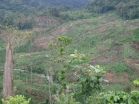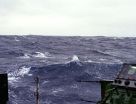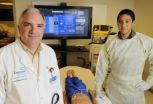(Press-News.org) Foreign pests are eating their way through our national forests, destroying majestic scenery and costing taxpayers millions of dollars.
If enforcement efforts to prevent their importation aren't stepped up, irreplaceable resources will be lost forever and taxpayers can expect to fork over billions of dollars by 2019, according to a comprehensive study published today in BioScience.
Researchers at the University of California at Santa Barbara, Michigan State University, the University of Central Florida and the United States Department of Agriculture Forest Service analyzed the impact of invasive insects and pathogens introduced into the United States through 2007.
What they found was a staggering list of more than 455 insects and 16 pathogens that are destroying everything from oak trees in California to redbay trees in Central Florida. Based on the pattern, the researchers predict one especially destructive pest will sneak into the nation every two years.
"Entire forests are being wiped out, and it is costing taxpayers millions as the government tries to eradicate invaders that threaten industries dependent on trees and plants," said Besty Von Holle, a UCF biologist who worked on the project. "We're losing a variety of native species as a result of importing these pests. It's not just aesthetics. It's impacting our economy."
These pests and diseases sneak into the country on everything from horticultural (or plant) imports to the wooden pallets used to transport building supplies, electronic goods and toilet paper, among other products.
"Global trade has had tremendous benefits for Americans," said lead author Juliann Aukema from the National Center for Ecological Analysis and Synthesis in Santa Barbara. "Unfortunately, it also has resulted in the introduction of destructive insects and other organisms that threaten native ecosystems and the services they provide."
No section of the country is immune.
Laurel wilt disease is one of the latest organisms to be spread by a foreign beetle in the southeastern United States. It is wiping out redbay trees in Georgia and last month was discovered in Seminole County, Fla. Redbay trees are important to wildlife, and certain butterflies depend on them for survival.
California has been battling sudden oak death, a pathogen that is destroying oak trees in California and Oregon since the 1990s. California has spent millions trying to stop it, because the trees are a state treasure.
The Asian longhorned beetle, which came into the United States hidden in wooden packing pallets, has ravaged all sorts of trees in New York City and Chicago. So far, those communities have spent $220 million fighting the infestation.
Another beetle, the emerald ash borer, has been destroying trees in the Midwest since 2002. It is estimated municipalities will spend more than $10 billion for landscape and tree treatments and removals in the next 10 years battling the ash borer.
"Once here, these invasive species are virtually impossible to stop," Von Holle said.
Recommendations include better screening before letting items into the country. The department within the USDA that is in charge of screening at airports and ports is now part of Homeland Security.
"These screening agents have too much to do, and right now the focus is on finding bombs and weapons," Von Holle said. "That's absolutely right, but we also need to be more aggressive about biological threats that could undermine large parts of the U.S. economy and harm our environment."
INFORMATION:
The research was supported by the Nature Conservancy and the National Center for Ecological Analysis, which is funded by the National Science Foundation. The research team also included Deborah G. McCullough at Michigan State University, Andrew Liebhold with the Northern Research Station of the U.S. Department of Agriculture, Kerry Britton with the USDA Forest Service and Susan J. Frankel of the USDA Forest Center at the Pacific Southwest Research Station in Albany, Calif.
Contacts:
Zenaida Gonzalez Kotala, UCF News & Information, 407-823-6120 or zkotala@mail.ucf.edu
Tracy Jones Connell, The Nature Conservancy, 703-247-3726 or tjonesconnell@tnc.org
UCF Stands For Opportunity --The University of Central Florida is a metropolitan research university that ranks as the second largest in the nation with more than 56,000 students. UCF's first classes were offered in 1968. The university offers impressive academic and research environments that power the region's economic development. UCF's culture of opportunity is driven by our diversity, Orlando environment, history of entrepreneurship and our youth, relevance and energy. For more information visit http://news.ucf.edu
San Diego, CA, December 7, 2010 – Obesity in youngsters has risen dramatically in recent decades. Fruit and vegetable (FV) consumption and increased water intake can lower the risk of obesity, as can increased physical activity, but it is not always easy to convince children to eat better and exercise more. In a new study published in the January 2011 issue of the American Journal of Preventive Medicine, researchers found that video games designed to encourage these behaviors were effective.
"Escape from Diab" (Diab) and "Nanoswarm: Invasion from Inner Space" (Nanoswarm) ...
The London School of Hygiene & Tropical Medicine (LSHTM) has contributed to a study showing that a low dose of aspirin reduces the occurrence of several common cancers. The study is published in today's Lancet.
The work was started and carried out by Professor Peter Rothwell in Oxford, and is based on an overview of several randomised trials of aspirin. These have been primarily concerned with reducing heart attacks, but have also gathered information on deaths from cancer.
The trial contributing most information to the overview has been the Thrombosis Prevention Trial ...
Scientists have created the highest resolution map of the Sumatran tiger distribution ever produced, revealing that the island now hosts the second largest tiger population on earth. The research, carried out with the Wildlife Conservation Society's Indonesia Program and Forum HarimauKita, will be published in a special issue of Integrative Zoology, on tiger conservation and research methodologies.
Hariyo T. Wibisono and Wulan Pusparini conducted a questionnaire-based survey across the island to identify the status of Sumatran tiger distribution. They found that tigers ...
The risk of having a heart attack is 60 per cent higher just a year after a patient has been diagnosed with rheumatoid arthritis, according to research published in the December issue of the Journal of Internal Medicine.
Swedish researchers followed 7,469 patients diagnosed with rheumatoid arthritis (RA) between 1995 and 2006, together with 37,024 matched controls without RA to determine the risk of ischaemic heart disease, with particular reference to myocardial infarction (heart attack). The maximum follow-up was 12 years and the median was just over four years.
"Our ...
Tapping into young people's use of online social networks presents health agencies with a powerful opportunity to help control the rise in HIV and other sexually transmitted infections in homeless youth in Los Angeles. According to new research1 by Sean Young from UCLA and Eric Rice from USC in the US, online social networking - and the topics discussed on these networks - have the potential to affect sexual risk behaviors. Targeting homeless youths with sexual health messages, by exploiting their use of these networks, is likely to be an effective way to reach and influence ...
A brand-new bacterial species has been found aboard the RMS Titanic, which is contributing to its deterioration. The discovery reveals a potential new microbial threat to the exterior of ships and underwater metal structures such as oil rigs.
The researchers, who report their findings in the latest issue of the International Journal of Systematic and Evolutionary Microbiology published on 8 December, isolated the micro-organisms from a 'rusticle', collected from the RMS Titanic, 3.8 km below the ocean surface.
The novel bacterium has been named Halomonas titanicae by ...
Researchers in South America have studied the viability of using earthworms to process hazardous material containing high concentrations of heavy metal for the bioremediation of old industrial sites, landfill and other potentially hazardous areas. They provide details of a possible approach in the International Journal of Global Environmental Issues this month.
After pollinating insects, worms are probably the gardener's best friend and they have been encouraged to process garden waste and soil for generations. The common earthworm, Eisenia fetida, could also become a ...
A team led by scientists at the United Kingdom's National Oceanography Centre have measured the air-sea exchange of carbon dioxide in the open ocean at higher wind speed then anyone else has ever managed. Their findings are important for understanding how interactions between the oceans and the atmosphere influence climate.
"Evaluating the factors influencing the transfer of gases such as carbon dioxide between the atmosphere and the ocean is needed for a full understanding of Earth's climate system," explained researcher John Prytherch of the National Oceanography Centre.
The ...
A well-known paper-based medical chart used by pediatric emergency personnel across America is undergoing a 21st century boost in an collaborative effort between Virginia Tech's College of Engineering, Roanoke-based Carilion Clinic Children's Hospital, and the physician who created the original method some 25 years ago.
The Broselow Pediatric Emergency Tape – otherwise known as the Broselow Tape -- has been a staple of ERs and child trauma units for nearly three decades. Created by Hickory, N.C.-based physician James Broselow, the Broselow Tape is a long, durable tape ...
Tel Aviv ― Naukrtis, a Greek trade emporium on Egyptian soil, has long captured the imagination of archaeologists and historians. Not only is the presence of a Greek trading settlement in Egypt during the 7th and 6th century B.C.E. surprising, but the Greeks that lived there in harmony hailed from several Greek states which traditionally warred amongst themselves.
Dr. Alexander Fantalkin of Tel Aviv University's Department of Archaeology is delving deeper into this unique piece of ancient history to come up with a new explanation for how Naukrtis developed, and ...



